How to Get Rid Of Birds
53 min read Updated for October, 2019
Most birds are a welcome part of the landscape, with their vibrant colors and pleasant songs. That isn’t always the case, though.
Some species may be considered a nuisance and are known to transmit diseases, in addition to the property damage they can cause. So, if your home has seen more of these particular birds than you’d like, you should look to measures that can relocate these unwanted visitors and prevent them from returning.
53 min read Updated for October, 2019

Sound
As varied as North American birds are, so are their sounds. From chirps and tweets, to a tuneful song, to shrieks and caws, rest assured you’ll know the sound of a bird when you hear it. If you have a bird in some part of your home, it’s possible the scuffling sounds you hear might be confused with a small rodent (mouse or squirrel); either way it’s vital to determine what is where within your house.
Tracks
Bird tracks are pretty easy to identify with three toes (claws) pointing forward and one pointing backward, and they generally hop—or scurry- when on the ground. Thus tracks are usually a few inches apart. Gulls differ in that they have webbed feet and all the toes are pointing forward.
Poop
Bird poop can vary in color and consistency depending on their diet—but as every car driver can attest to—it’s generally of a liquid consistency, whitish (waste from the kidney that seems to wrap abound the feces), and splatters. If you have birds living near or in your home, you will notice an increase of this splatter on your property.
Identify
Common Species
Three types of nuisance birds—pigeons, house sparrows, and European starlings—are most familiar to the United States. All are non-native and have no natural predators, having been introduced from Europe. Unlike most birds, these species are not protected against control or elimination by the Migratory Bird Treaty and Endangered Species Act.
With each of these, their nests may clog pipes and attract insect pests, and their droppings can mar the appearance of buildings and vehicles. So how do you tell these birds apart?
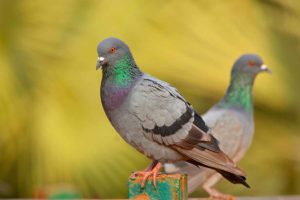
Pigeon
Perhaps the most-disliked of the group, pigeons are sometimes called “flying rodents” due to the filth they carry and their potential to spread disease. Making matters worse, they tend to group wherever they expect to find food—which is often near people (as in, don’t feed them).
Appearance
- Up to 11 inches in length and about 13 ounces in weight
- Grayish bodies with two black bars on each wing and red feet
Behavior
- In developed areas, will flock to parks, outdoor restaurants, and near trash bins
- In rural areas, will gather near farms, grain mills, food manufacturing plants
- Known carriers of insect pests and several diseases
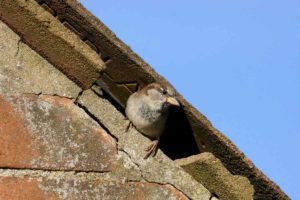
House Sparrow
Since arriving in America from Europe in the 1850s, the house sparrow has become the most abundant species in the nation. Their year-round breeding typically produces four to seven offspring per clutch.
Appearance
- Five to six and a half inches in length and less than one ounce in weight
- Reddish-brown bodies with black markings and a gray underbelly
Behavior
- Will eat vegetables, fruits, flowers, trash, and spilled foods
- Produce almost continuous, high-pitched, sharp cheeping sounds
- Will eat and contaminate livestock feed in rural areas
- Nests may become fire hazards in buildings and damage foam insulation
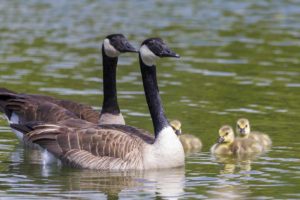
Canada Goose
Geese are much larger than other nuisance birds and are easy to spot. Unlike the species mentioned above, though, this bird is protected by federal and state laws that ban their handling, capture, or killing. Most control activities require permits.
Appearance
- 22-48 inches tall
- Weigh up to 24 pounds
- Tan and black with a large, white patch on each cheek
Behavior
- Usually build nests of twigs, grass, bark, and leaves near bodies of water and prefer temperatures of less than 50 degrees
- Diet consists of grass, corn, soybeans, and wheat
- Will become aggressive if the nest is approached
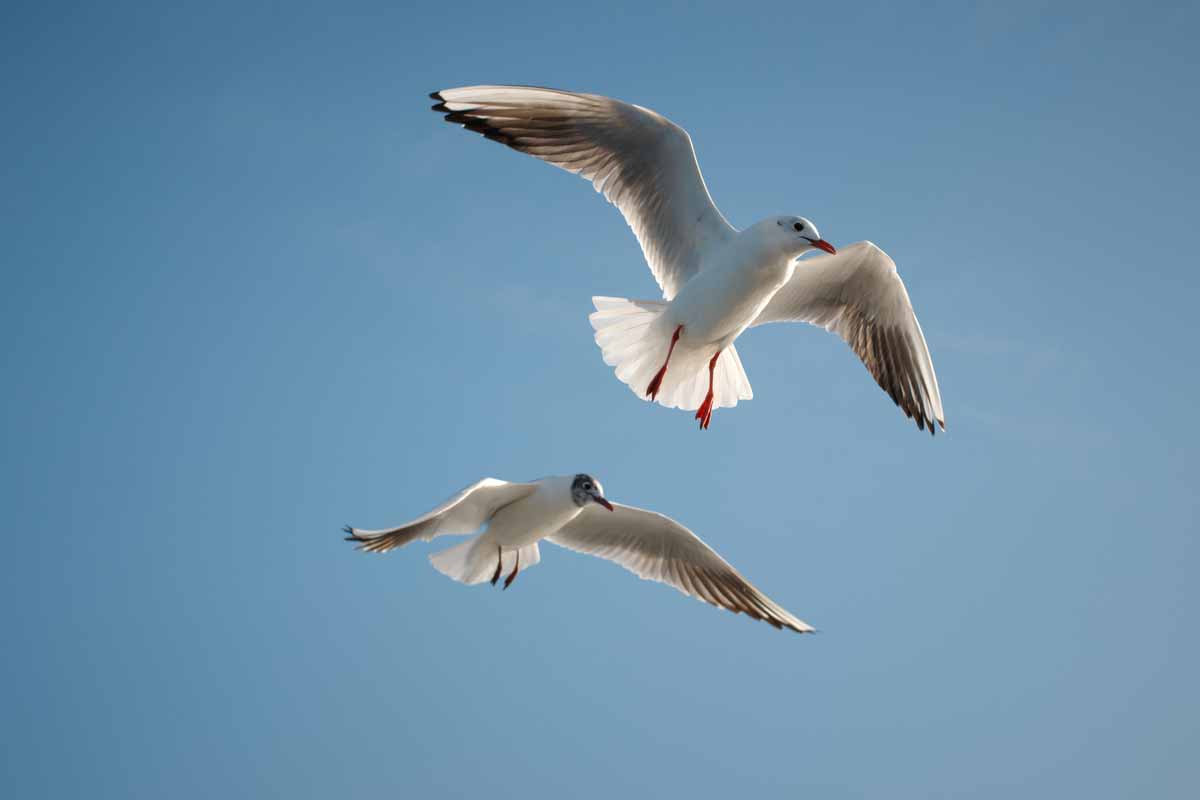
Gulls
As you would expect, gulls often live near bodies of water. But in developed areas, they’re known to frequent rooftops, parking lots, and landfills—any site that offers a food source and an escape route when threats approach.
Appearance
- Range in weight from six ounces to four pounds
- Webbed feet, long wings, and a hooked beak
- Typically white with patterns of gray and black over the back, wings, and head
Behavior
- Migratory by nature and will leave an area when a body of water freezes
- Diet consists of plants (especially berries), small insects, and trash
- Known to cause safety issues near airports
Treating Your Property For Birds
What if you have nuisance birds that haven’t responded to other tactics (screens, plastic predators, etc.)? Scented repellents offer another option. Birds don’t smell in the same way people do, but certain chemicals will make them uncomfortable enough to leave the area. See the following products.
If you’re looking to avoid chemicals, know that birds are quite sensitive to sound as well. This option gives you another set of options as sound devices have proven successful as deterrents to nuisance birds. The good news: These products use sounds humans can’t hear.
Bird Problem?
Every home carries a variety of features and nooks that are perfect for nesting or roosting.
Common Locations
For each of these birds, neither geography nor climate matter much. You’ll find them from coast to coast—which means removal and relocation are your best options. But what is it about your home that might be attractive to birds?
Every home carries a variety of features and nooks that are perfect for nesting or roosting. This includes ledges, front or back porch eaves, attic vents, garage rafters, downspouts, gutters, or the tops of brick walls.
Look at the outdoor areas of your property. Trees are always the first choice for birds seeking to nest, but you do want to keep the nuisance species away—especially since they can carry disease. While you don’t want to rid your yard of trees, you’d be wise to remove limbs that are reasonably close to the ground and those that reach the side or roof of your home.
If your yard has any thickets or large piles of grass or wood, these should be removed as well to prevent ground nests. Also check for sources of standing water in planters or decorative objects since pigeons, sparrows, and starlings may look for a drink.
So, what makes birds choose these spots in and around your home?
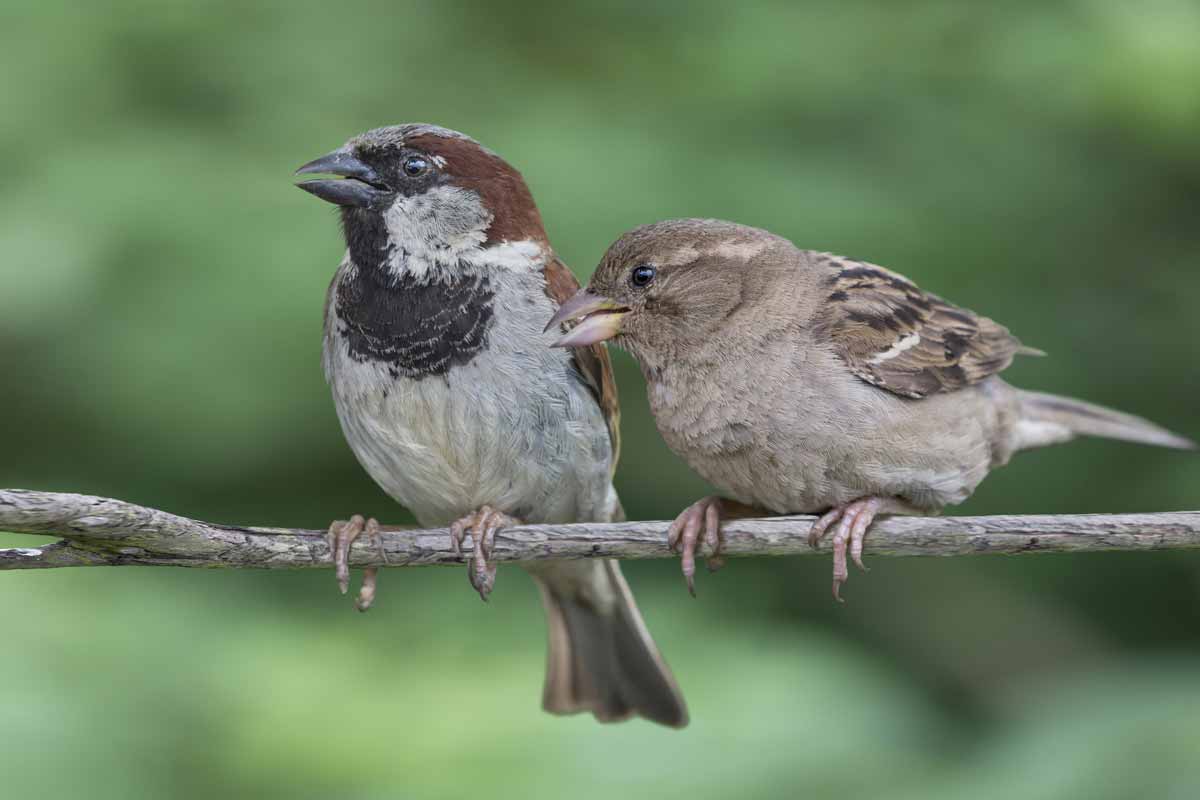
The mother will seek out a safe spot but also one that’s near a reliable food source, such as small insects, vegetables, and fruits.
Why They’re There
When you see birds nearby, it’s because they’ve found one of these opportunities.
Elevation
It’s expected for these birds to seek out flat surfaces that are high above the ground. Higher ground helps them stay clear of predators prowling on the surface. Away from residential areas, pigeons will even roost in airplane hangars and storage facilities.
Protection
The more secluded a location, the better off it is for the bird. Yet, flying predators such as hawks and owls present another problem and will gladly swoop in to invade a nest. This leads birds to seek out spaces harder for larger predators to breach. Sparrows can fit into holes as small as one and a quarter inches in diameter, while starlings need only one and five-eights of an inch to squeeze through.
Care for young
Keeping vulnerable eggs safe is a prime factor in the nest’s location. The mother will seek out a safe spot but also one that’s near a reliable food source, such as small insects, vegetables, and fruits.
You may be wondering if there’s a point at which you should take action to remove the birds or prevent their return. There is, and here are the signs:
- Droppings become one inch deep or more
- Nests obstruct necessary equipment or gutters
- Nests appear to become a fire hazard
- You locate 10 or more birds after three inspections of the area
Sound
As varied as North American birds are, so are their sounds. From chirps and tweets, to a tuneful song, to shrieks and caws, rest assured you’ll know the sound of a bird when you hear it. If you have a bird in some part of your home, it’s possible the scuffling sounds you hear might be confused with a small rodent (mouse or squirrel); either way it’s vital to determine what is where within your house.
Tracks
Bird tracks are pretty easy to identify with three toes (claws) pointing forward and one pointing backward, and they generally hop—or scurry- when on the ground. Thus tracks are usually a few inches apart. Gulls differ in that they have webbed feet and all the toes are pointing forward.
Poop
Bird poop can vary in color and consistency depending on their diet—but as every car driver can attest to—it’s generally of a liquid consistency, whitish (waste from the kidney that seems to wrap abound the feces), and splatters. If you have birds living near or in your home, you will notice an increase of this splatter on your property.
Inspect
Should I Relocate Birds?
To answer this question, think about the current state of your property, health, and the costs of taking action. You’ll need to consider:
Concerns about disease
Because birds can transmit illnesses, you may need to relocate them if your immune system is less than adequate.
Property damage
While the Canadian goose won’t cause damage to your home, other species can impact your house or car and cause cosmetic damage from their droppings. Pigeons, in particular, will live in attics because of the safety and dryness of the environment. These birds may also bring nesting materials into your home that can clog vents.
The money involved
This depends on the methods you’re willing to use, whether you’re able to handle the job yourself, and what products will affect the birds nearby.

Gather the Tools You’ll Need
Leather gloves
Protects your hands as you work to remove a nest.
Half-mask respirator
Purifies the air so you don’t breathe in pollutants as you relocate birds. Look for a pre-assembled model.
Headlamp
Improves visibility in tight or dark spaces and keeps your hands free.
Safety goggles
Look for an anti-fog, hard-coated lens for the best protection.
Ladder
Helpful for reaching elevated nests. Search a model rated for weights up to 300 pounds, and that exceeds OSHA standards.

Treating Your Property For Birds
What if you have nuisance birds that haven’t responded to other tactics (screens, plastic predators, etc.)? Scented repellents offer another option. Birds don’t smell in the same way people do, but certain chemicals will make them uncomfortable enough to leave the area. See the following products.
If you’re looking to avoid chemicals, know that birds are quite sensitive to sound as well. This option gives you another set of options as sound devices have proven successful as deterrents to nuisance birds. The good news: These products use sounds humans can’t hear.
Bird Problem?
Make sure the chimney flue is closed to prevent them from entering your living space.
How to Steps for DIY Removal
“What if a bird has flown inside my house?”
Perhaps the bird fell down your chimney or entered through an open door. Either way, stay calm. Don’t yell and don’t attempt to chase your flying visitor out with a broom. The bird doesn’t wish to be there any more than you. Here are the steps to usher it out.
Step 1: Block access to other rooms by closing doors.
Step 2: Leave a window or door open to the outside.
Step 3: Give the bird a moment to view the room and find the exit. Simply put, it wants to leave.
NOTE: It’s possible the bird is injured. You should never handle an injured animal on your own. Contact a local wildlife control specialist to handle the bird properly.
“I hear baby birds in my chimney? What should I do?”
Chimneys are often sought out by birds as preferred places to start their family. While this may be an inconvenience to you, allowing the parent birds to raise their young gives them the best opportunity to leave. Just make sure the chimney flue is closed to prevent them from entering your living space. The young birds should fly away within two to three weeks.
Also, don’t use the fireplace until the birds have left. Consider having your chimney cleaned to prevent a fire hazard and install a chimney cap to cut off birds’ access for the future.
“I want to remove the nest myself but protect the birds.”
In that case, make sure you have the protective clothing and tools necessary—items such as leather gloves, a half-mask respirator, head-lamp, safety goggles, and a ladder. Your greatest concern should be your safety because you want to avoid inhaling or coming in contact with infected birds or their droppings, which can spread disease.
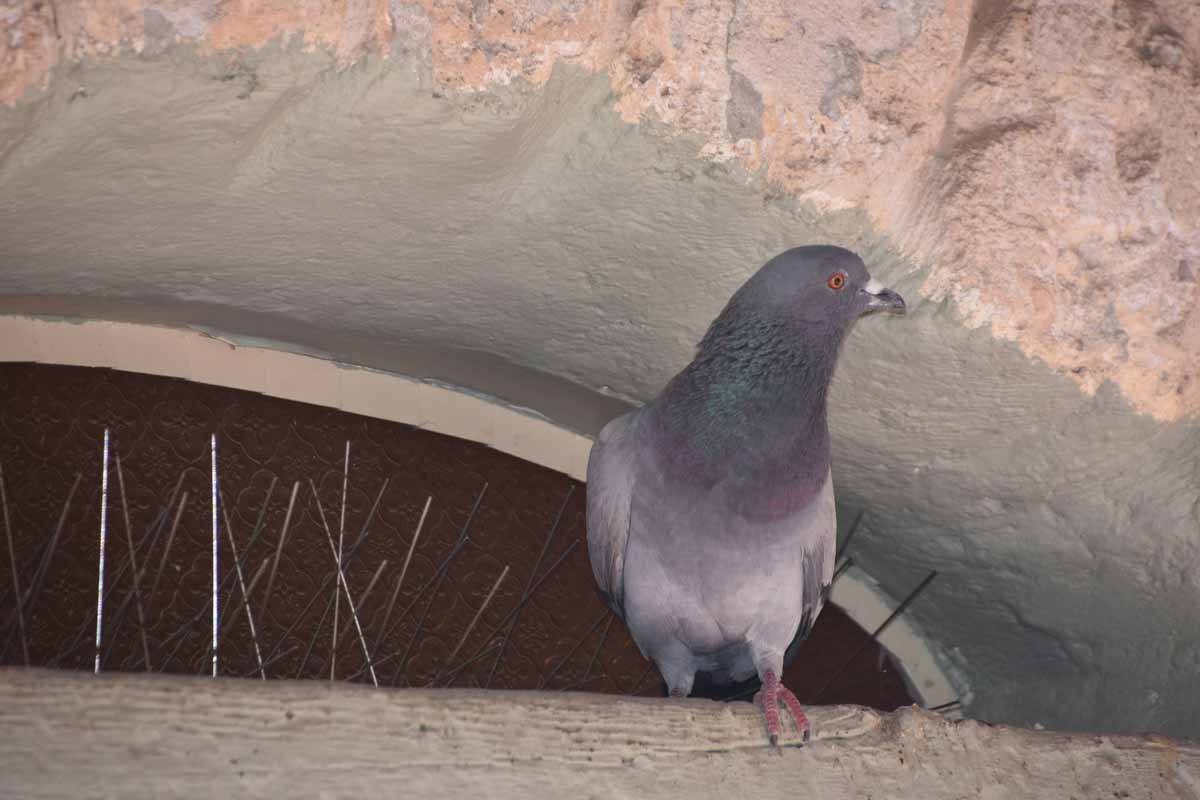
Crush dry green or red chili peppers and place them in water.
DIY Treatments
It’s also possible to craft or mix up an effective bird repellent using household items. Some of the simplest materials or strong-smelling spices can produce the desired result.
Shiny objects
People like bright, shiny objects, but birds don’t. Hang reflective items such as tin cans, CDs, and strips of aluminum foil near nesting areas, and birds will clear out.
Chili pepper spray
Crush dry green or red chili peppers and place them in water. Then cook the solution in a crock pot for several hours. Pour the liquid into a plant mister and spray the areas where you’ve seen nests.
Large “eye” balls
If you have any large, colorful balls for playground use, then you have a powerful deterrent for birds. Draw big circles in black and red on the balls to give the appearance of eyes. Then hang them from trees or fence posts. Birds will confuse these with the eyes of a predator and fly away. Kids’ pinwheels may have a similar effect.
Garlic oil
As a non-toxic, natural repellent, garlic is both inexpensive and quite effective. Its powerful aroma will keep birds at a distance. Be aware, though, that the oil may wear off quickly and even ward off beneficial insects.
A note about ammonia and mothballs: Both have sometimes been considered useful as repellents, but this information is wrong. Mothballs carry a mixture of chemicals that—when applied incorrectly —can irritate the eyes, lungs, and skin. Ammonia can cause burning of the eyes, nose, and throat. Neither is useful for ridding your home and property of nuisance birds because the birds are not sufficiently discouraged from the area by the scent.
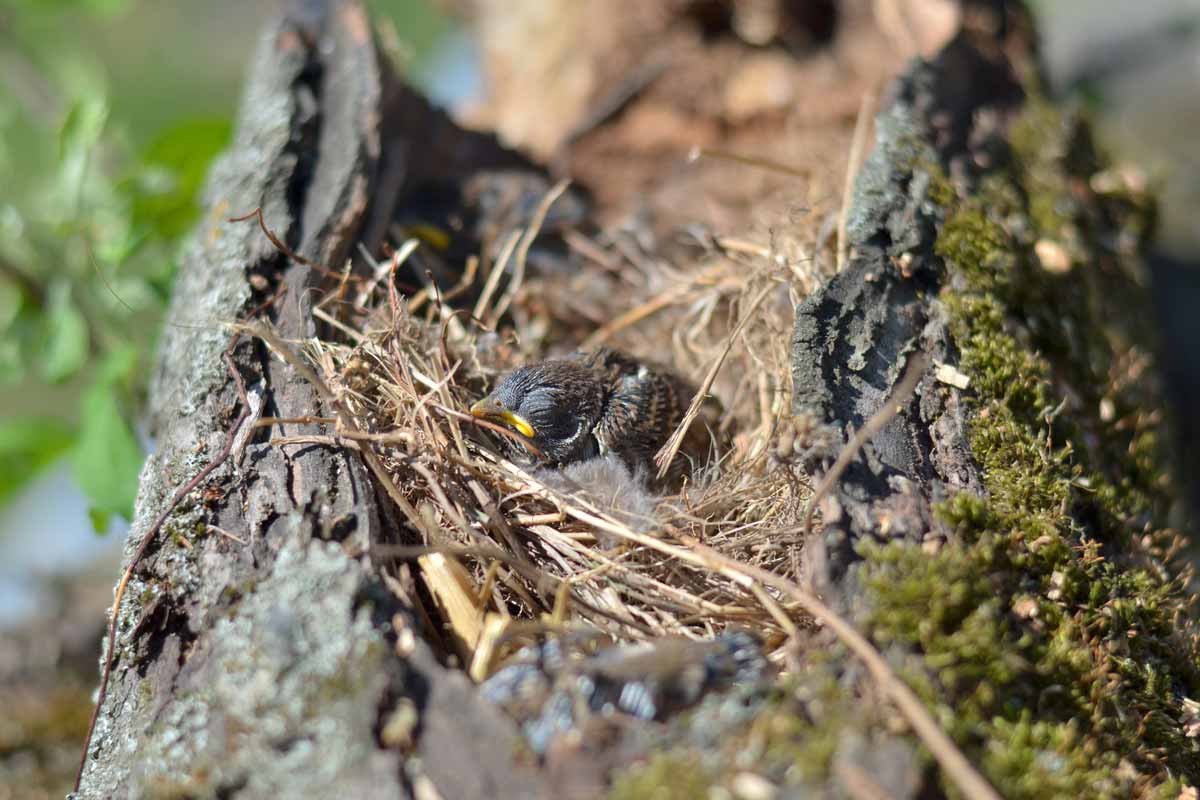
Pigeons are the most likely to spread disease through their waste—more than 60 different illnesses.
Risks of disease
Bird droppings are usually more of a nuisance than an actual health risk, though the concern is more significant for people with weakened immune systems. And of the nuisance birds, pigeons are the most likely to spread disease through their waste—more than 60 different illnesses. Diseases travel when their droppings dry out, become powdery, and are picked up by the wind.
The most common pathogens that can transmit disease from pigeons to humans are:
- E. coli: Occurs when droppings mix with water or food that people consume. Symptoms include nausea, fever, and cramps.
- St. Louis encephalitis: Spread by mosquitoes after feeding on an infected bird. Symptoms include drowsiness, headache, and fever.
- Histoplasmosis: Carried in a fungus that grows in droppings. Potentially fatal as a respiratory ailment.
- Candidiasis: Also caused by a fungus or yeast in pigeon waste. Can impact skin, mouth, intestines, and respiratory system.
- Salmonellosis: Often called food poisoning and spreads via powdery pigeon waste that contaminates food.
Making matters worse, pigeons can carry mites, fleas, and West Nile virus – all of which can lead to serious illness in humans.
So, while you may appreciate the presence of birds near your home, you certainly don’t want even the possibility of becoming infected by bacteria or viruses from the waste that comes from a nuisance species. How do you prevent this from happening?
Sound
As varied as North American birds are, so are their sounds. From chirps and tweets, to a tuneful song, to shrieks and caws, rest assured you’ll know the sound of a bird when you hear it. If you have a bird in some part of your home, it’s possible the scuffling sounds you hear might be confused with a small rodent (mouse or squirrel); either way it’s vital to determine what is where within your house.
Tracks
Bird tracks are pretty easy to identify with three toes (claws) pointing forward and one pointing backward, and they generally hop—or scurry- when on the ground. Thus tracks are usually a few inches apart. Gulls differ in that they have webbed feet and all the toes are pointing forward.
Poop
Bird poop can vary in color and consistency depending on their diet—but as every car driver can attest to—it’s generally of a liquid consistency, whitish (waste from the kidney that seems to wrap abound the feces), and splatters. If you have birds living near or in your home, you will notice an increase of this splatter on your property.
Prevent
Prevention Methods

Protect the exteriors
Window ledges, eaves, exposed pipes, dormers, and other outside surfaces give birds places to land, loiter, and build nests. When their nests clog drains or gutters, there’s the potential for standing water that can result in roof damage. Deny them a residence there by installing a physical barrier such as porcupine wire or even piano wire about an inch above those areas.
If your eaves need screening, remember these measurements:
- Three-quarters of an inch for sparrows
- One and one-eighth of an inch for starlings
- Two and a half inches for pigeons
Screening will prevent entry and nest building. To defend your intake vents, dormer covers, soffits, and exhaust fan ductwork, buy half an inch of mesh hardware cloth.
A chemical reaction
Here’s a new phrase to learn: polybutylene repellents. When applied to ledges or outdoor-facing beams, these non-toxic chemicals feel sticky to birds as they seek a comfortable landing spot. It’s an effective measure that shoos birds away without harming them.
Treating Your Property For Birds
What if you have nuisance birds that haven’t responded to other tactics (screens, plastic predators, etc.)? Scented repellents offer another option. Birds don’t smell in the same way people do, but certain chemicals will make them uncomfortable enough to leave the area. See the following products.
If you’re looking to avoid chemicals, know that birds are quite sensitive to sound as well. This option gives you another set of options as sound devices have proven successful as deterrents to nuisance birds. The good news: These products use sounds humans can’t hear.
Bird Problem?
If you have a bird feeder or bath, make sure it’s positioned a generous distance from your home.
Keep your yard clean
This doesn’t mean lawn maintenance. Instead, we’re talking about clearing away debris and keeping your trash can lids secure so birds can’t dine on available discarded food. Also: If you have a bird feeder or bath, make sure it’s positioned a generous distance from your home.
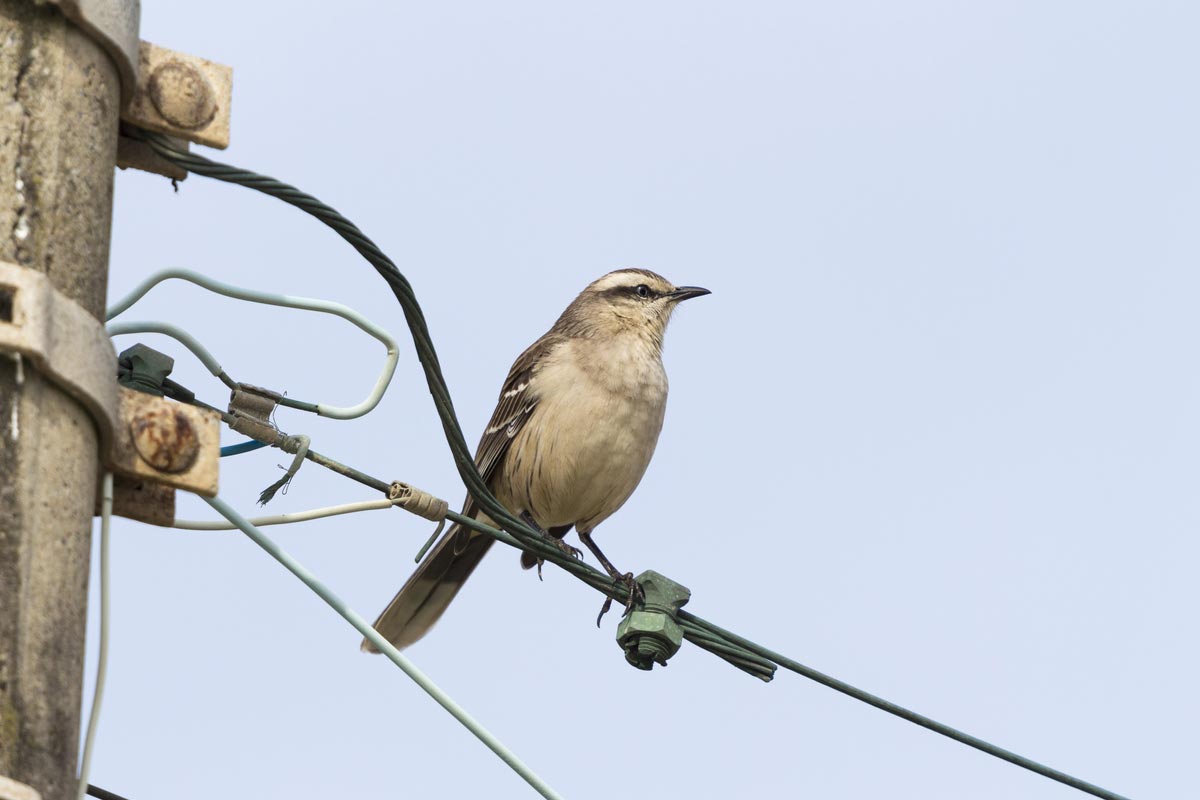
Plastic predators
A fake hawk, owl, coyote or other predator placed in your yard or on your porch can scare off nuisance birds. Just change its location now and then to surprise any flying visitors. Remember, though, that fake animals tend to be more of a short-term solution.
Diversions
Whether in the form of shiny metals that are harsh on a bird’s eyesight or in the image of a giant eyeball, these diverters can fend off birds through visual stimuli.
Fence them out
Whether electric or non-electric, a fence—preferably at least 30 inches tall —will prevent Canadian geese from entering your space and stop other types from loafing nearby. However, the price and labor involved can make installation of a fence cost-prohibitive.
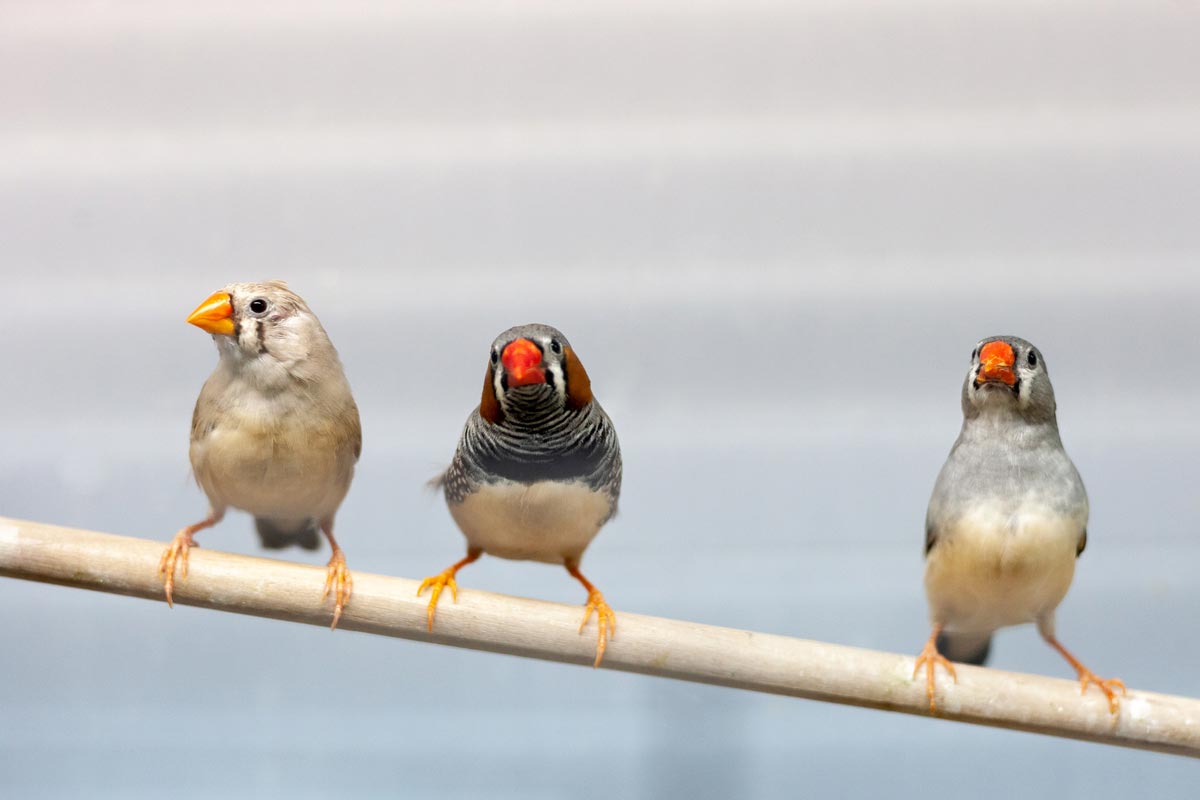
Experts in wildlife control consider nets one of the best methods for stopping bird access to areas of a home.
Give them a shower
If you invest in a sprinkler system, especially one with motion sensors, the spray will activate to scare away a bird every time it approaches.
Nothing but net
Experts in wildlife control consider nets one of the best methods for stopping bird access to areas of a home or building for nesting or roosting. Netting materials have improved in recent years, but the placement of nets still requires skill.
Keep them off the ledge
Many deterrent products can be attached to the ledges of your home. These products include wires, lines, flappers, slants, spikes, coils, and shock tape. These are usually easy to place on the exterior and very useful. Just use keywords like “bird spikes,” “bird coils,” and “shock tape” on Amazon to quickly find these products.
Sound
As varied as North American birds are, so are their sounds. From chirps and tweets, to a tuneful song, to shrieks and caws, rest assured you’ll know the sound of a bird when you hear it. If you have a bird in some part of your home, it’s possible the scuffling sounds you hear might be confused with a small rodent (mouse or squirrel); either way it’s vital to determine what is where within your house.
Tracks
Bird tracks are pretty easy to identify with three toes (claws) pointing forward and one pointing backward, and they generally hop—or scurry- when on the ground. Thus tracks are usually a few inches apart. Gulls differ in that they have webbed feet and all the toes are pointing forward.
Poop
Bird poop can vary in color and consistency depending on their diet—but as every car driver can attest to—it’s generally of a liquid consistency, whitish (waste from the kidney that seems to wrap abound the feces), and splatters. If you have birds living near or in your home, you will notice an increase of this splatter on your property.
Treat
Treatment Methods
What if you have nuisance birds that haven’t responded to other tactics (screens, plastic predators, etc.)? Scented repellents offer another option. Birds don’t smell in the same way people do, but certain chemicals will make them uncomfortable enough to leave the area. See the following products.
If you’re looking to avoid chemicals, know that birds are quite sensitive to sound as well. This option gives you another set of options as sound devices have proven successful as deterrents to nuisance birds. The good news: These products use sounds humans can’t hear.
Bird Problem?
Sound
As varied as North American birds are, so are their sounds. From chirps and tweets, to a tuneful song, to shrieks and caws, rest assured you’ll know the sound of a bird when you hear it. If you have a bird in some part of your home, it’s possible the scuffling sounds you hear might be confused with a small rodent (mouse or squirrel); either way it’s vital to determine what is where within your house.
Tracks
Bird tracks are pretty easy to identify with three toes (claws) pointing forward and one pointing backward, and they generally hop—or scurry- when on the ground. Thus tracks are usually a few inches apart. Gulls differ in that they have webbed feet and all the toes are pointing forward.
Poop
Bird poop can vary in color and consistency depending on their diet—but as every car driver can attest to—it’s generally of a liquid consistency, whitish (waste from the kidney that seems to wrap abound the feces), and splatters. If you have birds living near or in your home, you will notice an increase of this splatter on your property.
When to Call a Professional
While most methods of preventing nuisance birds are easy to manage on your own, some are more time-consuming and expensive. If you’ve used a variety of techniques, though, and don’t see your bird problem improving, it may be time to call an expert. Here are the telltale signs that you’ll need help from a wildlife control specialist:
- You’re planning to use a trap, exclusion doors, bird nets on a large scale
- Your exclusion devices have captured a large number of birds and requires removal
- Your DIY steps haven’t been successful
- You’ve seen a high number of pest birds in and around your home
Remember that some species of nuisance birds can carry diseases, so an infestation can be a health concern for you and your family. Don’t hesitate to call a bird professional if you feel the birds have altered your health and daily life on your property.
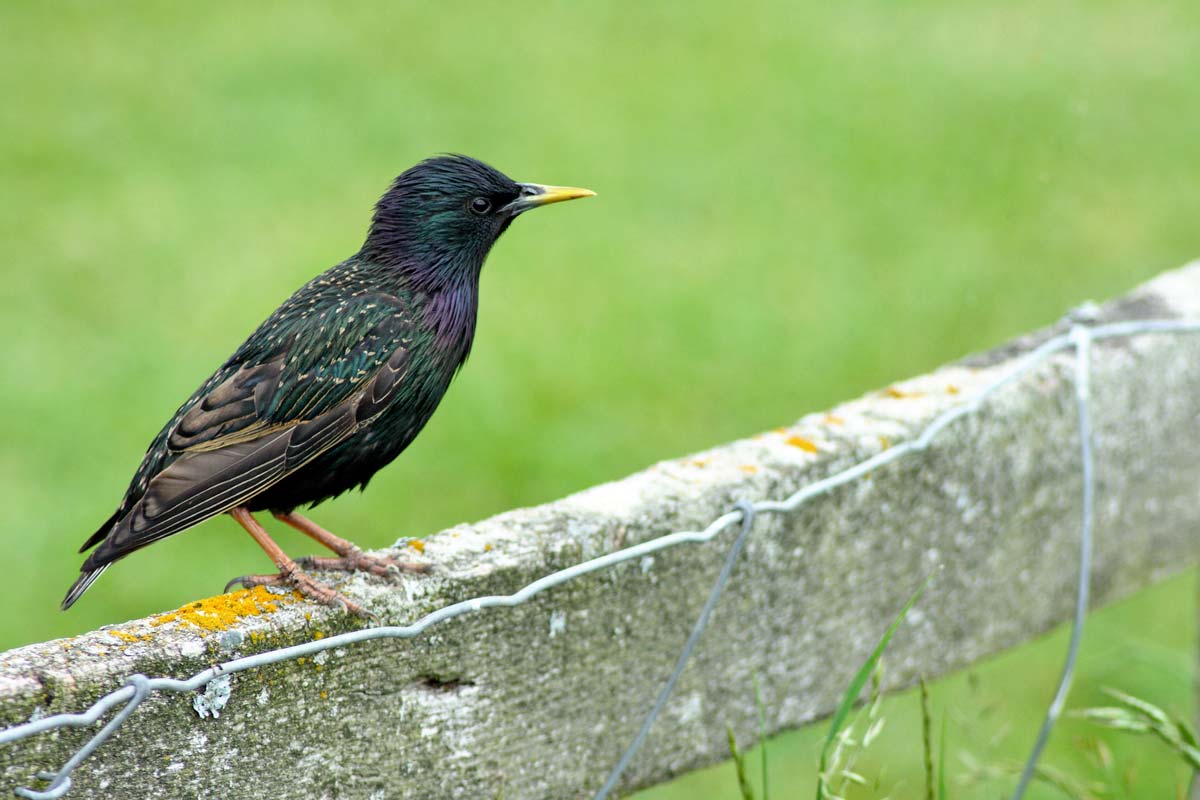
Sources
National Wildlife Control Training Program: Structural Pest Control Program – Bird Management Manual
Dealing with Nuisance Birds Around School – EPA webinar
https://www.falconforce.com/problem-birds.html “Problem Birds”
https://www.audubon.org/birds/faq#t1431n8941 “Frequently Asked Questions About Birds”
https://www.varmentguard.com/blog/birds-choose-nest/ “How Do Birds Choose Where to Nest?”
https://m.extension.illinois.edu/wildlife/faq.cfm#faq-118 “Living with wildlife in Illinois”
https://www.edwards.af.mil/News/Article/394114/prevent-nests-to-keep-nuisance-birds-away/ “Prevent nests to keep nuisance birds away”
https://www.terminix.com/blog/home-garden/help-keep-birds-away/ “How to help keep birds away”
https://www.terminix.com/blog/education/can-pigeons-spread-disease/ “Can Pigeons Spread Disease?”
https://www.birdbgone.com/resource-center/pest-bird-diseases.html “Pest Bird Diseases”
https://www.thespruce.com/natures-beauty-spoiled-by-pest-birds-2656529 “Nature’s Beauty Spoiled by Pest Birds”
Treating Your Property For Birds
What if you have nuisance birds that haven’t responded to other tactics (screens, plastic predators, etc.)? Scented repellents offer another option. Birds don’t smell in the same way people do, but certain chemicals will make them uncomfortable enough to leave the area. See the following products.
If you’re looking to avoid chemicals, know that birds are quite sensitive to sound as well. This option gives you another set of options as sound devices have proven successful as deterrents to nuisance birds. The good news: These products use sounds humans can’t hear.
Bird Problem?
Sources
http://www.naturetracking.com/bird-tracks/
https://www.wildernesscollege.com/bird-tracks.html
https://www.birdmedicineandsurgery.com/diseases.php
Sound
As varied as North American birds are, so are their sounds. From chirps and tweets, to a tuneful song, to shrieks and caws, rest assured you’ll know the sound of a bird when you hear it. If you have a bird in some part of your home, it’s possible the scuffling sounds you hear might be confused with a small rodent (mouse or squirrel); either way it’s vital to determine what is where within your house.
Tracks
Bird tracks are pretty easy to identify with three toes (claws) pointing forward and one pointing backward, and they generally hop—or scurry- when on the ground. Thus tracks are usually a few inches apart. Gulls differ in that they have webbed feet and all the toes are pointing forward.
Poop
Bird poop can vary in color and consistency depending on their diet—but as every car driver can attest to—it’s generally of a liquid consistency, whitish (waste from the kidney that seems to wrap abound the feces), and splatters. If you have birds living near or in your home, you will notice an increase of this splatter on your property.




